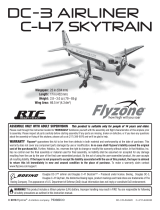
14
2. After the sequence of beeps representing the desired function, lower the throttle stick to enter the programming mode for that
function. The ESC will beep as indicated below waiting for your command to change the setting:
Advance the throttle after number of beeps (one
beep, two beeps, three beeps) indicating the new
setting. Hear the tones (“ 1 2 1 2”) indicating the
value has been set and saved. Immediately lower the
throttle stick (within two seconds) to exit programming
mode proceeded by the number of short beeps
counting the number of LiPo cells, followed by one
long beep (“beeep”) indicating the model is ready to
fl y. Or, disconnect battery at any time to exit
programming mode.
If the throttle stick is left in advanced programming mode, programming will resume where it left off—simply listen for the
sequence of beeps that represents the next function, then lower throttle stick to enter the programming mode for that function.
EXAMPLE:
To set brake from the factory default of “off” to “on”:
1. Advance the throttle stick. Turn on the transmitter.
2. Connect battery.
Three tones (“
1 2 3”) followed by:
Two short beeps (“beep beep”) followed by:
5-second pause followed by:
Five tones (“ 1 2 3 4 5”)
The ESC is now in the Programming Menu.
3. After one short beep (“beep”) lower throttle stick. You are now in the brake programming function.
4. Listen for beeps: one beep = brake off, two beeps = brake on. If you do nothing ESC will simply
loop through the sequence of beeps—once, then twice, then once, then twice, etc. waiting for your
command to turn the brake on or off. To turn the brake on advance throttle stick after the two beeps.
Listen for the tones (“ 1 2 1 2”) indicating that the setting has been set and saved. If that’s all you
wanted to set, immediately lower the throttle stick (within two seconds) to exit programming mode,
then hear the number of beeps correlating to the number of cells in your battery (three or four)
followed by one long beep (“beeep”) indicating that the model is ready to fl y.
III. ESC Troubleshooting Guide:
Problem Reason Action
Motor does not work, no tones or beeps are
coming from the ESC.
There is a problem with the connection between
the battery and ESC.
Motor does not work, Alert Tone sounds
(“beep beep,” “beep beep,” “beep beep,”…)
Motor does not work, Alert Tone sounds
(Long beeps: “beeep beeep beeep…”)
Motor does not work, Alert Tone sounds
(Rapid beeps: “beepbeepbeepbeepbeep…”)
Motor does not work, five tones are sounded
(“ 1 2 3 4 5”) after the two beeps.
The motor turns the wrong direction.
Battery voltage is too high or too low.
There is a problem with the throttle signal.
Throttle stick is not in the lowest position, or
throttle needs to be calibrated.
The direction of the throttle channel is reversed
and the ESC has entered the Programming Menu.
The three motor wires are incorrectly connected
to the ESC.
Check the plugs or change the plugs if the wires
are damaged.
Make sure the battery is charged and/or you are
using the correct battery.
Check the transmitter and receiver and check the
connection between the ESC and the receiver.
Lower the throttle stick all the way, or recalibrate
the throttle per calibration instructions.
Set the throttle direction in the transmitter the
other way.
Swap any two of the motor/ESC wire connections
with each other.
Function One Beep Two Beeps Three Beeps
1 Brake
Battery type
Timing
Start mode
Cutoff voltage
Cutoff mode
Brake
Battery type
High (26.25°)
Super soft
High (3.3 V)
Cutoff mode
On
NiMH
Medium (15°)
Soft
Medium (3.15 V)
Hard
Off
LiPo
Low (3.75°)
Normal
Low (2.85 V)
Soft
4
5
2
3
6





















